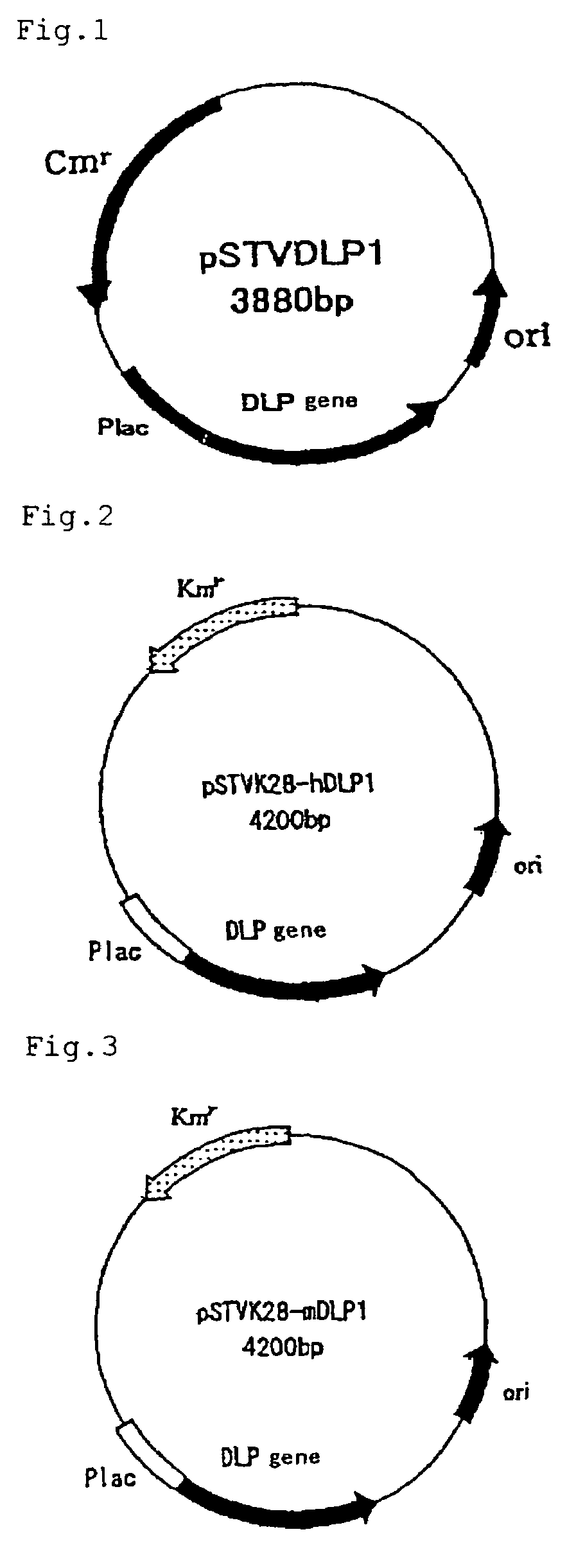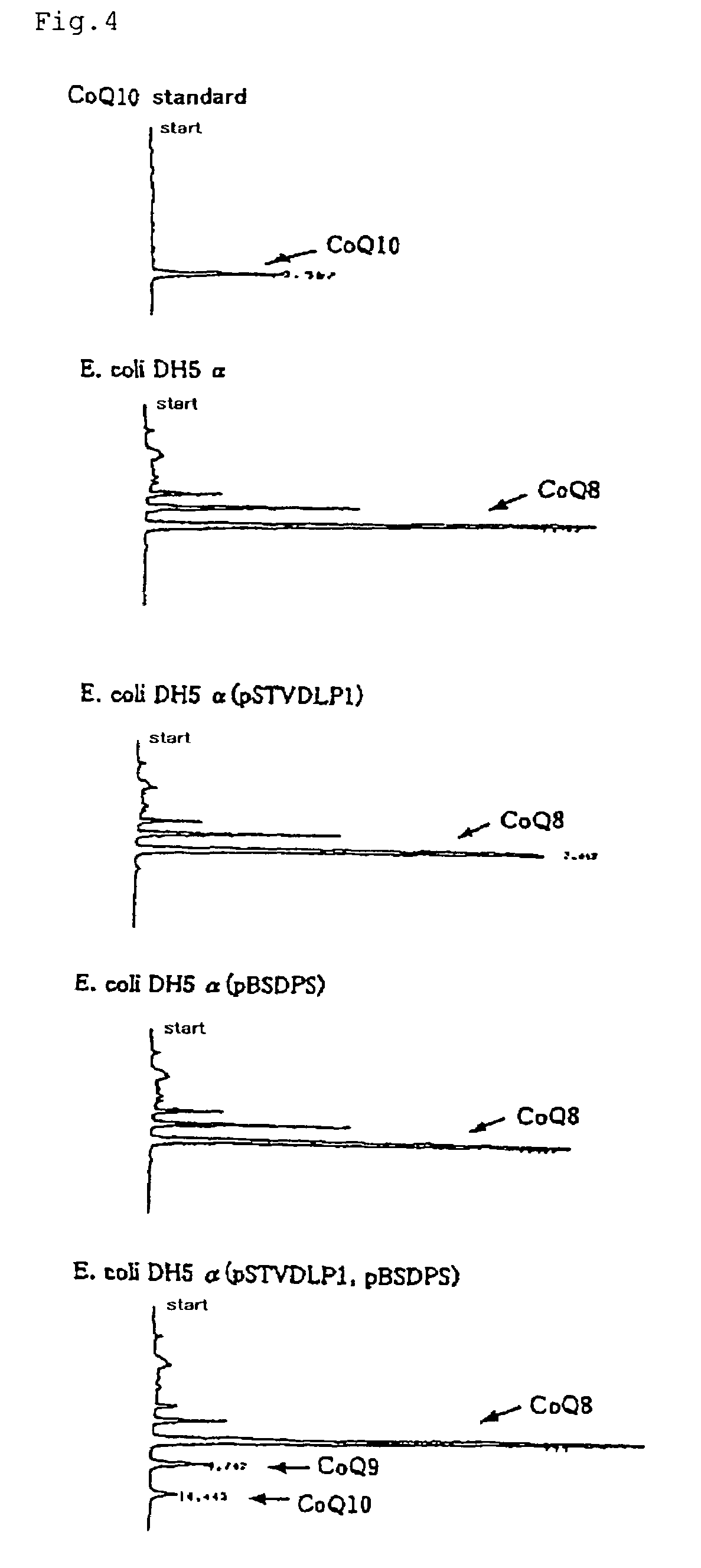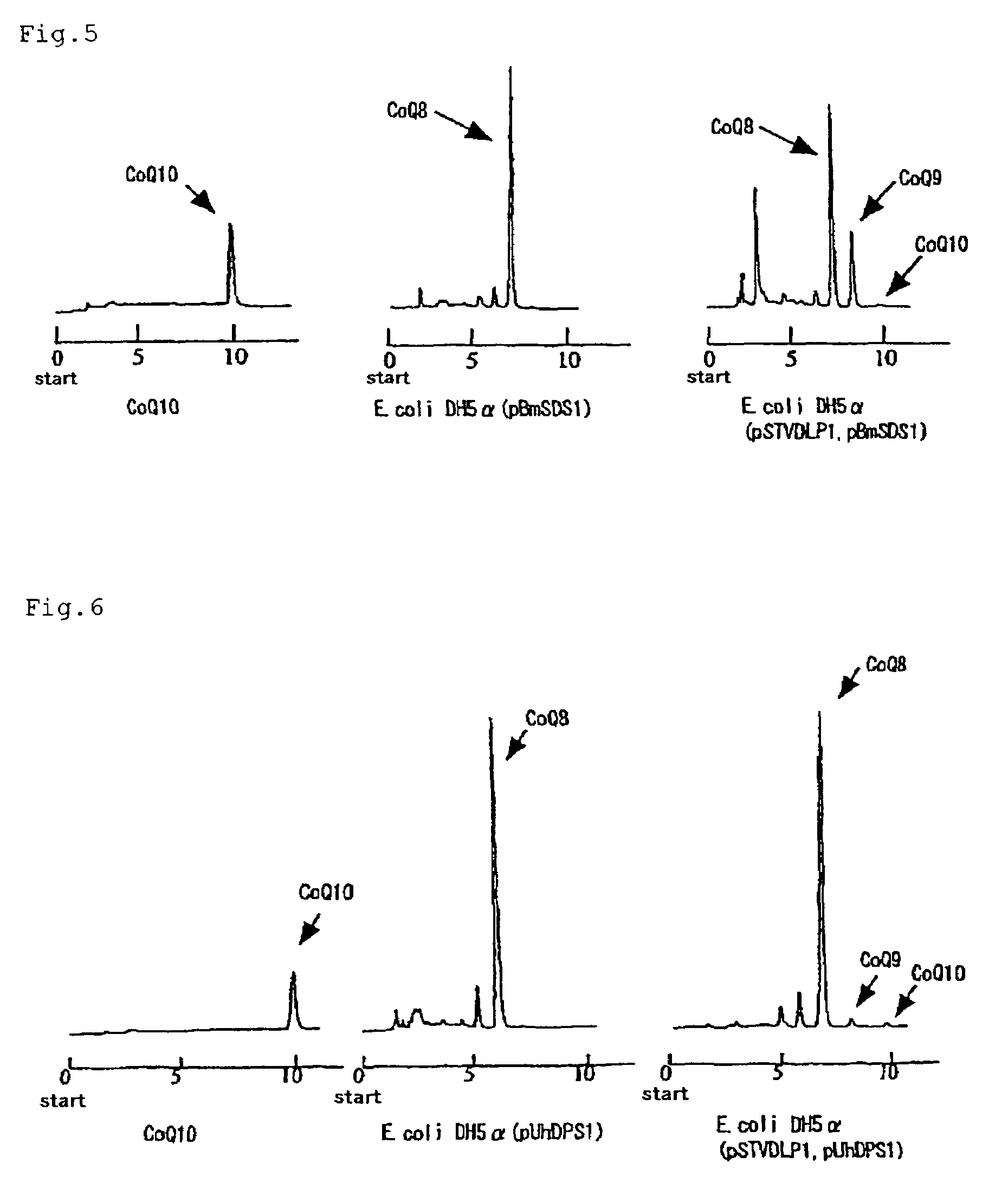Method of expressing long-chain prenyl diphosphate synthase
a prenyl diphosphate and long-chain technology, applied in the field of long-chain prenyl diphosphate synthase, can solve problems such as unsatisfactory activity production, and achieve the effect of better results
- Summary
- Abstract
- Description
- Claims
- Application Information
AI Technical Summary
Benefits of technology
Problems solved by technology
Method used
Image
Examples
example 1
[0067]Using the base sequence of the decaprenyl diphosphate synthase gene of Schizosaccharomyces pombe, homology search was conducted in the Sanger Center database and, as a result, a gene having 26% homology was found out by means of GENETYX (Software Development Co., Ltd.). PCR primers, N-dlp1 (SEQ ID NO:7) and C-dlp1 (SEQ ID NO:8), were prepared for obtaining that gene. Separately, the chromosomal DNA of Schizosaccharomyces pombe IFO 1628 was prepared by the method of C. S. Hoffman et al. (Gene, 57 (1987), 267-272). Using these, PCR was carried out by 2 minutes of heat treatment at 94° C. followed by 25 repetitions of the following cycle: one minute at 94° C.→one minute at 56° C.→two minutes at 72° C. The thus-amplified DNA was analyzed by 0.7% agarose gel electrophoresis.
[0068]The thus-obtained fragment of about 900 bp was excised from the gel, purified using a DNA extraction kit (Sephaglas (trademark) BandPrep Kit, product of Amersham Pharmacia Biotech) and then cloned in a vec...
example 2
[0071]Using the base sequence of the DLP1 gene of Schizosaccharomyces pombe as obtained in Example 1, homology search was conducted in a Genbank database and, as a result, a gene having 27% homology was found out by means of GENETYX (Software Development Co., Ltd.). PCR primers, hDLP1-N (SEQ ID NO:9) and hDLP1-C (SEQ ID NO:10), were prepared for obtaining that gene. Using a human liver cDNA library (cDNA Library, Human Liver, plasmid type (product of Takara Shuzo)) as a template, PCR was carried out by 2 minutes of heat treatment at 94° C. followed by 35 repetitions of the following cycle: one minute at 94° C.→one minute at 56° C.→two minutes at 72° C. The thus-amplified DNA was analyzed by 0.7% agarose gel electrophoresis.
[0072]The thus-obtained fragment of about 1,200 bp was excised from the gel, purified using a DNA extraction kit (Sephaglas (trademark) BandPrep Kit, product of Amersham Pharmacia Biotech) and then cloned in a vector for expression in Escherichia coli using a PCR ...
example 3
[0074]Using the base sequence of the DLP1 gene of Schizosaccharomyces pombe as obtained in Example 1, homology search was conducted in a Genbank database and, as a result, a gene having 31% homology was found out by means of GENETYX (Software Development Co., Ltd.). PCR primers, mDLP1-N (SEQ ID NO:11) and mDLP1-C (SEQ ID NO:12), were prepared for obtaining that gene. Using a murine liver cDNA library (cDNA Library, Mouse Liver, plasmid type (product of Takara Shuzo)) as a template, PCR was carried out by 2 minutes of heat treatment at 94° C. followed by 35 repetitions of the following cycle: one minute at 94° C.→one minute at 56° C.→two minutes at 72° C. The thus-amplified DNA was analyzed by 0.7% agarose gel electrophoresis.
[0075]The thus-obtained fragment of about 1,200 bp was excised from the gel, purified using a DNA extraction kit (Sephaglas (trademark) BandPrep Kit, product of Amersham Pharmacia Biotech) and then cloned in a vector for expression in Escherichia coli using a PC...
PUM
| Property | Measurement | Unit |
|---|---|---|
| temperature | aaaaa | aaaaa |
| catalytic activity | aaaaa | aaaaa |
| side chain length | aaaaa | aaaaa |
Abstract
Description
Claims
Application Information
 Login to View More
Login to View More - R&D
- Intellectual Property
- Life Sciences
- Materials
- Tech Scout
- Unparalleled Data Quality
- Higher Quality Content
- 60% Fewer Hallucinations
Browse by: Latest US Patents, China's latest patents, Technical Efficacy Thesaurus, Application Domain, Technology Topic, Popular Technical Reports.
© 2025 PatSnap. All rights reserved.Legal|Privacy policy|Modern Slavery Act Transparency Statement|Sitemap|About US| Contact US: help@patsnap.com



